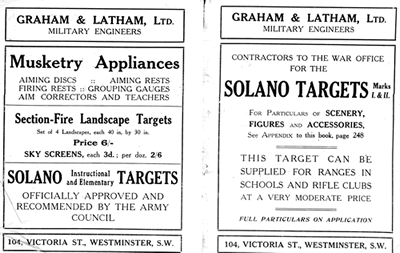 ........
........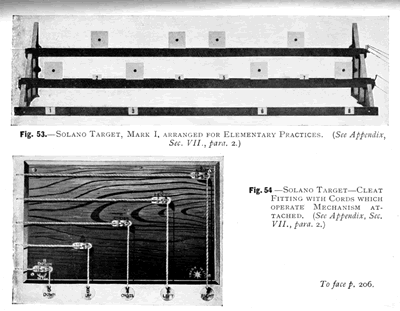
Please be aware that some specialist imagery may take time to load.
This site is designed for dedicated researchers on desktop or tablet, not ideal for mobile browsing.
SEE ALSO: ...LANDSCAPE TARGETS......... .SWIFT TRAINING RIFLE TARGETS.........NOVELTY TARGETS.........LEAGUES TARGETRY...... SMRC & NSRA TARGETRY
Designed by Captain E.J. Solano, an Engineer officer on the Imperial General Staff during the First World War, and used to train recruits and provide miniature-calibre short-range rifle practice over the next three decades or more in various emulated derivative guises, this basic system was in common use - even at the Musketry School at Hythe in Kent. Solano wrote much material on infantry training, and had a number of training papers and manuals published, particularly in the Imperial Army Series published by Murrays of Albemarle Street, London.
The Solano system was officially approved by the Army Council for military training.
As well as being used for Landscape targetry, the framework upon which that system relied could also be used for elementary practice on standard targets , or on the specially designed range of Solano targets based upon the quite reasonable premise that, by comparison with a circular aiming-mark, firstly, the triangular aiming-mark resulted in a more realistic representation of the human form on the battlefield and, secondly, that the triangle presented a more accurate indication of hits that might have been scored on the human frame in the field.
The basic target frame setup is shown below, along with two contemporary advertisements for the targets and the system respectively.
 ........
........
Here follows a self-explanatory extract on the Solano Targets from a Musketry manual of 1915.
The targets are shown at near actual size to permit an opportunity to try them on your range.
A confirmation scale can be gained from the actual height dimension of Elementary Target No.1 ( Fig. 67), which is 106mm.
VIII. SOLANO ELEMENTARY AND INSTRUCTIONAL TARGETS.*
1. In Musketry Regulations,
para. 361, it is laid down that in carrying out training on miniature ranges due regard must be paid to the visibility of service targets, and bull's-eye
targets must be used for the first few rounds only. In para. 206 (iii)
of Musketry Regulations (see Sec. 17, para. 4 of this book) focussing the
eye on the fore-sight of the rifle instead of on the object is indicated
as a common fault which instructors must guard against in elementary stages
of training. This error is common when bull's-eye targets are used, and
unless remedied will adversely affect shooting at service Targets, on which
the eye must be focussed, and which must be watched closely when firing.
2. Elementary Targets (Figs. 67 and 68).-The Solano Elementary Targets have
been designed to counteract the tendency to focus the eye on the fore-sight
instead of on the target, and may be used for grouping and application practices
after firing at the bull's-eye target. These targets are coloured green,
brown, and grey, instead of white, to accustom the eye to the tints of natural
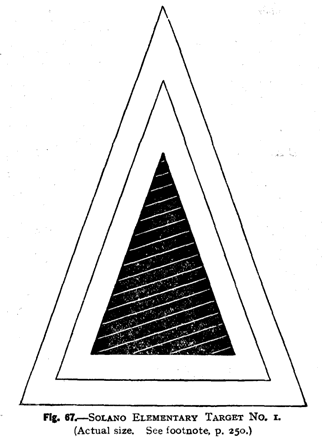
backgrounds against which service targets will be seen. The aiming-mark
in No. 2 is less distinct than in No. I, to accustom the eye gradually to
focussing on indistinct targets when aiming.
* The illustrations of these Targets in this section only show the aiming-marks and scoring diagrams. These are printed in the centre of square card surfaces of convenient size in the usual manner, the cards being green, grey, or brown, instead of white.
3. Triangle Aiming and Scoring Diagrams.-
(i) Triangles have been substituted in these targets for concentric circles as aiming and scoring diagrams, because they have a truer relation to the shape
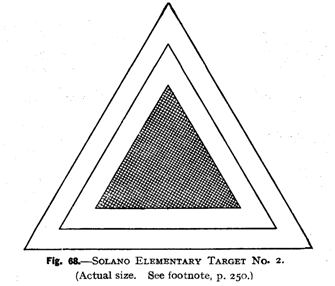
of the human figure in both lying and upright positions. The triangle on
No. I target has relation to the human figure in an upright position, and
the triangle on No. 2 target to the human figure in a lying position. The
dimensions of the triangles on these targets correspond with the regulation
grouping standards of the British Army.
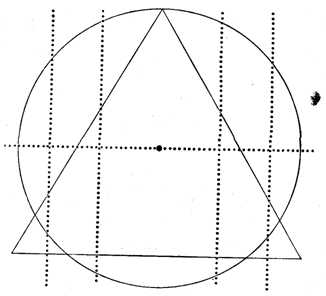
Fig. 69.-A CIRCLE (3 INCHES IN DIAMETER) AND A TRIANGLE (3 INCHES EQUILATERAL)
SHOWING THAT THE TRIANGLE AS AIMING AND SCORING DIAGRAM INDUCES CLOSER GROUPING
THAN THE CIRCLE BY ALLOWING LESS MARGIN FOR BOTH VERTICAL AND LATERAL ERRORS
REPRESENTED BY THE DOTS.
(ii) For elementary instruction in aiming the important six o'clock line,
the centre of the base of the triangle is, on these targets, an indicated
instead of an imaginary line, as in the case of the circular bull's-eye.
More consistent grouping is induced by the triangle owing to the fact that
it allows a much narrower
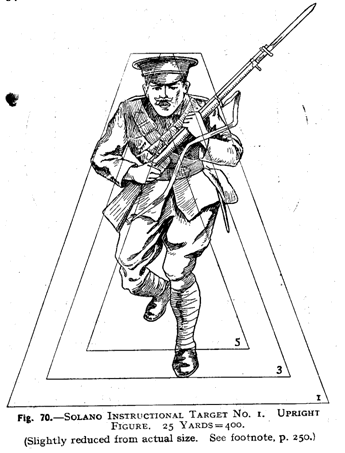
margin for lateral errors, while its conical shape and straight base considerably
curtail the scoring area for vertical errors off
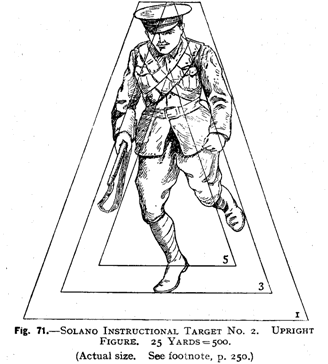
the six o'clock line as compared with the circle (Fig. 69). The triangle,
moreover, as an aiming and scoring surface puts a
premium upon a low point of aim and from the first inculcates in men, as
a habit, this vital principle of marksmanship in war.
(iii) The centre triangles are not made smaller, firstly, because it is
not desired to encourage the habit of slow aim which is engendered by individual
practice at very small marks, and which militates against efficiency in
snapshooting and rapid firing ; and, secondly, because it is not desired
to encourage men to attain a useless and disproportionate degree of excellence
in firing at
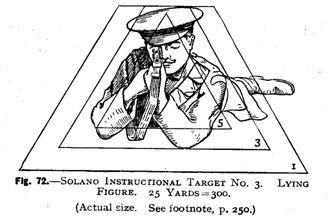
elementary targets which is merely preparatory for practice at service targets.
4. Instructional Targets (Figs. 70, 71, and 72).-
(i) These targets are also coloured green, grey, and brown, the colour of the uniform of the figures on them corresponding in each case with that of the target. The figures are accurately scaled down to correct size at 25 yards for the actual distances, so as to help men in judging close range by accustoming the eye to the ap¬pearance of men seen at different distances against backgrounds which harmonize with the colour of their uniform. It must be remembered that the figures on these targets, though necessarily depicted in fixed postures as stationary marks, represent men in movement during which they are seldom stationary or seen in a fixed posture, except, possibly, for a few seconds while lying down to fire.
(ii) Accordingly, marks are not given for hits scored on any particular
part of the figures depicted in fixed postures, which would usually be seen
in movement, but for shots grouped in areas of comparative value as regards
probable assurance of fire effect, chosen in the light of experience of
war as the best aiming points for firing at figures in movement which frequently
and suddenly alternate between the upright and lying positions. The centre
triangles, representing the most valuable of these grouping areas, are purposely
made fairly large for the reasons stated in connection with the elementary
Below: an actual target, illustrating the colouring intended to best represent that to be expected in the field.
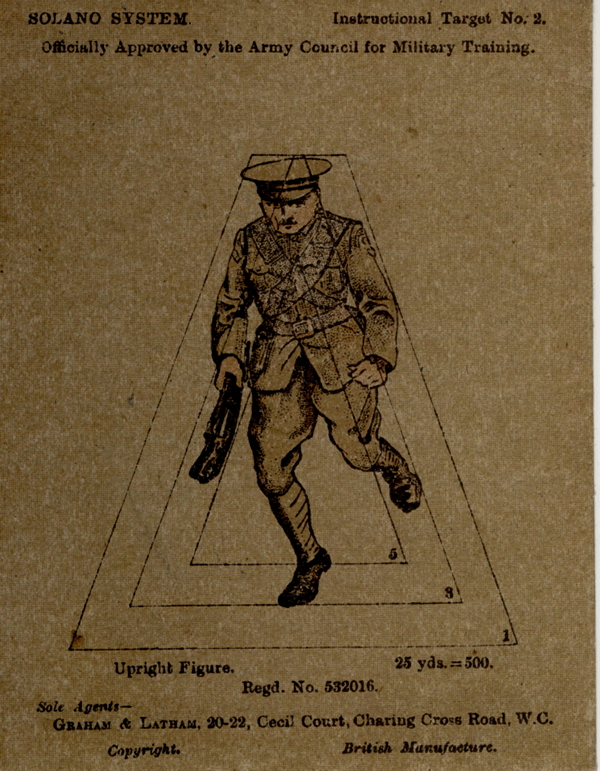
SEE ALSO A SELECTION OF NOVELTY
MILITARY STYLE TARGETS
Return to: TOP of PAGE
See this website's Raison d'être